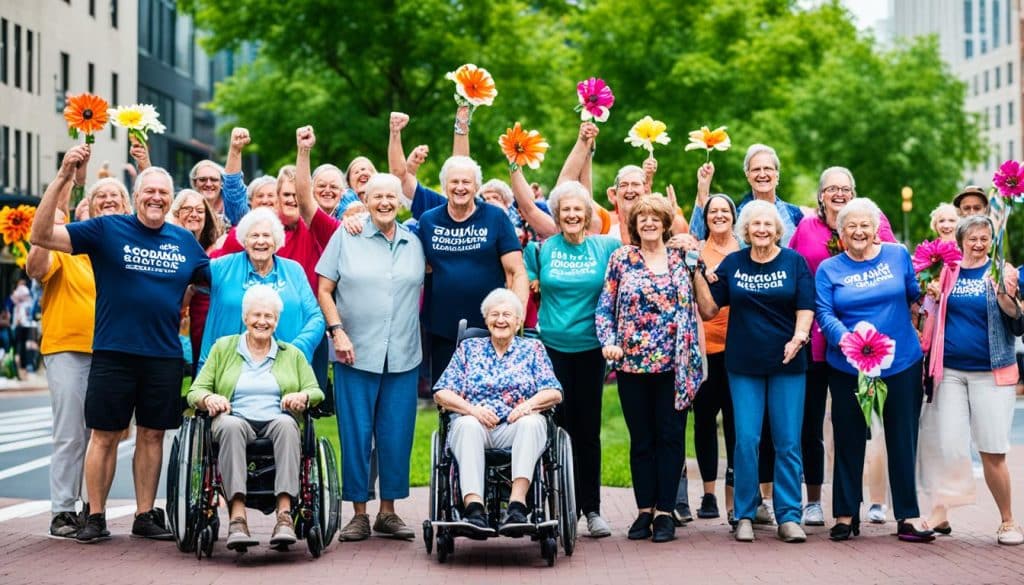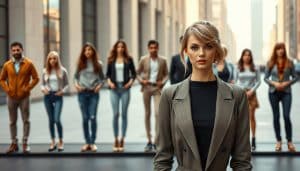Life can throw big challenges our way. You may have faced tough times that seemed too hard to get through. Yet, Helen Keller’s story shows us that overcoming tough spots is doable. Despite losing her sight and hearing early on, she became an inspirational figure in history. Helen’s life story is not just about beating disability. It’s a powerful message that pushes us to break past our own barriers.
Helen Keller was born on June 27, 1880, in Tuscumbia, Alabama. Her life moving from darkness into a role of intellectual and social influence is a testament to human resilience1. After losing her sight and hearing early, she made history by graduating with a Bachelor of Arts degree from Radcliffe College in 1904, with honors2. Keller didn’t stop there. She helped start Helen Keller International in 1915 to aid soldiers blinded in World War I2. Her lasting impact continues to motivate and bring about positive global change, marking her as a timeless symbol of determination.
Key Takeaways
- Helen Keller’s biography demonstrates the triumph of resilience and determination over adversity.
- Born in 1880, Helen Keller lost both sight and hearing at a young age but defied the odds.
- She graduated cum laude from Radcliffe College in 1904, becoming the first deafblind person to earn a Bachelor of Arts degree.
- In 1915, she co-founded Helen Keller International to help soldiers blinded in World War I.
- Helen Keller’s legacy continues to inspire and positively affect global change.
Early Life and Family Background
Helen Keller, a truly amazing historical figure, was born on June 27, 1880, in Tuscumbia, Alabama34. Her early years caught the interest of many people. They marked the beginning of an incredible journey.
Birth and Family
Helen Keller’s early life was shaped by her family and upbringing. She was the eldest of two girls born to Arthur H. Keller, an ex-Confederate Army officer and newspaper editor, and Katherine Adams Keller. Though not rich, the family earned their living from a cotton plantation and Arthur’s work as a local newspaper editor3.
The Keller family, despite financial challenges, provided Helen with a loving home. Her birth and family circumstances greatly influenced her formative years.
Early Development
As a young child, Helen Keller was full of promise. She started talking and walking very early. These milestones showed her potential for normal intellectual and physical development. Her childhood in Tuscumbia, Alabama, played a key role in her early experiences with the world3. It showed her family’s dedication to nurturing her talents.
Loss of Sight and Hearing
Helen Keller was only 19 months old when she got very sick. Some think it was meningitis or scarlet fever. This illness caused a high fever. Because of it, she lost her sight and hearing5. This was a huge change for Helen. It marked the start of many challenges in her life. But, Helen’s story is also about her incredible strength and resilience.
Losing her sight and hearing so young was very hard for Helen. It changed her life completely. But, Helen Keller’s story teaches us something important. It shows that with enough courage and hard work, you can do amazing things5. The illness at 19 months was a turning point. It set the stage for her future work and fights for rights.
We’re not sure if Helen had scarlet fever or meningitis. But that illness was a key moment in her life. It made her completely deaf and blind. Her parents wanted to help her. So, they introduced her to Anne Sullivan in 18875. Meeting Anne was a big deal for Helen. It changed how she learned and communicated.
| Year | Event |
|---|---|
| 1880 | Helen Keller was born |
| 1882 | Illness leading to loss of sight and hearing |
| 1887 | Met Anne Sullivan |
The Arrival of Anne Sullivan
Anne Sullivan came from the Perkins School for the Blind to teach Helen Keller on March 5, 18876. When she reached the Keller house, she faced a lot of challenges. Helen didn’t want to learn or communicate.
Initial Challenges
Anne Sullivan met several hurdles as Helen Keller’s new tutor. Helen’s lack of cooperation made teaching her hard. Yet, Sullivan’s determination started to make a difference. Her patience and dedication were truly remarkable.
Breakthrough at the Water Pump
A key moment happened at a water pump. Here, Anne Sullivan helped Helen link the feel of water to the letters w-a-t-e-r spelled on her hand. This was Helen Keller’s first step towards communication7.
This event showed how staying persistent and using new ways to teach can make a big difference. Thanks to Sullivan’s guidance, Helen learned 575 words, simple math, and Braille in six months6. This was the start of Helen’s amazing growth with Sullivan by her side until she passed away on October 20, 19366.
Helen Keller’s Education Journey
Helen Keller’s education journey shows her strong will and the support she got. When she was seven, she met Anne Sullivan in 1887. This meeting was a key moment8. Sullivan helped Keller start to communicate, teaching her 30 words in just a few hours in April 18879.
First Steps in Learning
Keller began learning Braille, a crucial skill for her9. At the Perkins School for the Blind, Anne Sullivan opened the world of education to her. Sullivan used sign language and lip-reading by touch to teach Keller9.
Going Beyond Basic Education
Helen Keller didn’t stop there; she took speech classes at the Horace Mann School for the Deaf9. She also attended the Wright-Humason School for the Deaf in New York City. There, she developed skills that led to her becoming the first deafblind person to graduate from Radcliffe College, cum laude, in 190498.
| Institution | Key Contributions |
|---|---|
| Perkins School for the Blind | Introduced sign language and Braille |
| Horace Mann School for the Deaf | Speech classes focused on refining communication |
| Wright-Humason School for the Deaf | Advanced education in various skills |
Keller’s experiences at these schools helped her beat being deafblind. She showed the world what you can achieve with courage, support, and creative teaching98. Her story remains a beacon, proving that with the right attitude, no hurdle is too big.
Radcliffe College Years
Helen Keller’s time at Radcliffe College was a landmark event in her life. It happened when she got in, in 1900. She became a symbol of hope at this top school connected to Harvard University1011. Her path had many hurdles. Yet, with hard work, Anne Sullivan’s help, and support from Henry H. Rogers, she succeeded.
Overcoming College Challenges
For Keller, being at Radcliffe College was tough, especially because of her disabilities. She had Anne Sullivan by her side always. This made things like taking exams and following lectures easier11. Keller worked hard. She used braille and standard typewriters for her work. Anne Sullivan and Polly Thomson helped her edit11. She loved learning about different languages and cultures through braille texts11.
Graduation and Accomplishments
Keller overcame many doubts and hurdles and graduated with honors in 1904. She was the first deafblind person in the U.S. to get a Bachelor of Arts degree1012. This achievement was huge for her and Radcliffe College11. While there, she grew a lot and did very well academically. She even joined Phi Beta Kappa10. Her story still inspires many people today.
The Story of My Life: Helen’s First Autobiography
In her autobiography, The Story of My Life, Helen Keller shares her journey from a young child to a 21-year-old college student. Published in 1903, this memoir has touched hearts around the globe. It showcases Helen’s fight against great challenges. The book, with 240 pages, was introduced to readers in 1902. It gives a detailed look at Helen’s experiences and struggles1314.
Helen shares the close relationships she had with family and her teacher, Anne Sullivan. About 70% of the memoir describes her struggle with disabilities14. It highlights letters from Anne Sullivan, giving insights into Helen’s learning and growth13. This book stands out for showing her endeavors and desire to learn.
The book also delves into Helen’s family and background. She was born in 1880 in Tuscumbia, Alabama, into a family with notable ancestors13. The Keller family home, “Ivy Green,” is remembered for its beautiful garden. It was here Helen spent her early years before becoming ill13.
Helen’s love for literature is a major theme in her story. She read about 15 books, including works by Shakespeare, Dickens, and Stevenson14. Books were crucial in her education and journey. She talks about a letter she wrote in 1891, showing her love for communication and learning14.
Helen faced many challenges in her education, like limited Braille books and the need for tests to be read out loud14. Despite these hurdles, she was determined to succeed. The Story of My Life is a testament to overcoming barriers in pursuit of knowledge.
Advocacy and Social Activism
Helen Keller became a powerful voice for those with disabilities and for social change15. She worked hard to bring about improvements worldwide.
Focus on Disability Rights
Starting in 1910, Keller focused on stopping blindness15. Her efforts showed her commitment to equal rights for the disabled15. She used her fame to spread her message by starring in “Deliverance” in 191915.
Involvement in Women’s Suffrage
Keller didn’t just fight for disability rights. By 1909, she was also working for women’s right to vote and peace16. She joined forces with groups pushing for change and civil rights16. In 1920, she helped start the American Civil Liberties Union, showing her deep commitment to justice for everyone15. Keller met with influential leaders and was active in rallies, always advocating for fairness16.
The Co-founding of Helen Keller International
In 191517, Helen Keller co-founded Helen Keller International. This organization plays a key role in fighting and preventing blindness across the globe. Initially, it helped World War I soldiers who lost their sight18.
Now, it has grown to address wider health issues. It focuses on preventing blindness and malnutrition among vulnerable groups worldwide.
Addressing Blindness
Helen Keller International prioritizes preventing blindness. By printing Braille books and music, it opens up education for those who can’t see17. The organization also funds surgeries and treatments to help restore sight.
Thanks to Keller’s hard work, individuals with vision loss are living full, independent lives today19.
Tackling Malnutrition
Fighting malnutrition is another goal of this organization. It knows that good nutrition can lower blindness rates. Through vitamin supplements and teaching about nutrition, it supports at-risk communities17.
These actions are a part of its mission to boost health and wellbeing on a global scale.
Helen Keller’s influence via her organization continues to impact global health17. Its ongoing battle against malnutrition and blindness is improving lives and building healthier communities around the world.
International Tours and Influence
Helen Keller changed the world on a huge stage. She traveled far, promoting important causes for the visually impaired. Between 1946 and 1957, she visited 35 countries on five continents. Her trips aimed to raise awareness for those with disabilities. They were about showing support and making a difference.
Wherever she went, Keller became a powerful influence. She met with leaders and worked with groups for disability rights. In Japan, in 1948, her talks helped improve life for disabled folks. Her work was respected across the globe.
Keller did more than give speeches. She shared Braille books and music in places like Belgium and France. Through her organization, Helen Keller International, she reached nearly 20 countries. Her efforts impacted the lives of 73 million children and families20. In 1937, her group made the first “talking book,” a big step for education for the visually impaired20.
Her tours did a lot for public awareness. Keller showed the world the importance of helping those with disabilities. Her work and dedication stand as a lasting tribute. It’s a legacy of global advocacy and cultural influence that still inspires today.
Honors and Awards
Helen Keller’s life was full of awards that showed her great work as a humanitarian. She got many awards and honors from different respected groups and organizations.
Presidential Medal of Freedom
In 1964, Helen Keller was honored with the Presidential Medal of Freedom. This award recognized her as an important leader in social activism. It made her a symbol of hope and strength for people worldwide1.
Honorary Doctorates
Besides the Presidential Medal of Freedom, Keller received honorary degrees from top universities. These awards highlighted her contributions to society and learning. Universities like Glasgow, Harvard, and Temple recognized her1.
| Award | Institution/Organization | Year |
|---|---|---|
| Presidential Medal of Freedom | United States Government | 1964 |
| Honorary Doctorate | Glasgow University | N/A |
| Honorary Doctorate | Harvard University | N/A |
| Honorary Doctorate | Temple University | N/A |
| Lions Humanitarian Award | Lions Clubs International | N/A |
| French Legion of Honor | French Government | N/A |
| Women’s Hall of Fame | National Women’s Hall of Fame | N/A |
Helen Keller also won the Lions Humanitarian Award and the French Legion of Honor12. These awards showed the world how much she did as a humanitarian. She was also inducted into the Women’s Hall of Fame, which highlighted her role in advocating for women’s rights12.
Helen Keller’s many honors and degrees show her big impact on the world. She overcame huge personal challenges. She worked hard for the rights of others, leaving a lasting legacy.
To learn more about her amazing life and work, check out this biography. It gives a closer look at her accomplishments.
The Miracle Worker: From Book to Screen
Helen Keller’s early life with her teacher Anne Sullivan is a tale of hope. It has been turned into many adaptations, including “The Miracle Worker.” The story shows the power of perseverance and communication. It first grabbed viewers on TV in 1957, sharing Keller’s journey from isolation to understanding.
Television Drama
In 1957, Keller’s autobiography was made into a TV drama. It was a big moment for her amazing story. The show put Helen Keller’s life and her special relationship with Anne Sullivan into homes across America. This version was the start of more adaptations to come. They would keep honoring Keller’s unbreakable spirit and her story’s huge impact21.
Broadway Play
The drama’s success led to a Broadway play of “The Miracle Worker.” It started in 1959 and won a Pulitzer Prize. The play showed the real physical and emotional challenges Keller and Sullivan faced. It helped the story become an important part of American culture. This play celebrated Keller’s achievements and started conversations on disability and education21.
Film Adaptation
The 1962 movie version of “The Miracle Worker” spread Helen Keller’s inspiring story even further. Patty Duke played Keller and Anne Bancroft was Sullivan. Both won Oscars for their amazing acting. The film is famous for the language learning scene by the water pump. However, some criticized it for simplifying Keller’s life.
Despite the criticism, the film made a big mark on culture. It showed the hard work and success in teaching a deafblind child21. Explore more about Keller’s relationships here.
Helen Keller’s Later Life
Helen Keller’s journey in her final years stayed inspiring. She had a stroke in 1961, leading to her retiring from public life. But, her impact didn’t fade away. Her writings and the legacy she built kept influencing the world.
In her late years, Helen Keller focused on her lasting impact. She had spoken in 35 countries across five continents from 1946 to 19574. Her travels showed her dedication to helping those with disabilities. She kept advocating for them even as she thought about retiring.
Even after retiring, Keller’s achievements kept making waves. She wrote over 475 speeches and essays, reflecting her commitment to important causes4. Her work and public speaking skills are a big part of her legacy.
Keller spent her retirement years writing and reflecting. She worked with the American Foundation for the Blind for over 40 years4. This work shows how dedicated she was to helping those with visual impairments.
For more on her impressive career, check this out here.
Legacy of Helen Keller’s Inspirational Life Account
Helen Keller’s story shows us the power of never giving up. She was born on June 27, 1880, in Tuscumbia, Alabama. At 19 months old, she became deaf and blind due to an illness2223. Yet, she became a beacon of hope, known for her push for education and rights for those with disabilities.
Her accomplishments are many. With her teacher Anne Sullivan’s help from 1887, Keller showed the world that people with disabilities can learn and excel22. She wrote books, like her autobiography “The Story of My Life,” touching lives worldwide2224.
Keller fought for others too. She helped start the American Civil Liberties Union and supported women’s right to vote24. She worked tirelessly, leading to better laws and education for people with disabilities.
One of her quotes, “The best and most beautiful things in the world cannot be seen or even touched — they must be felt with the heart,” shows her belief in our inner power22. Keller’s legacy inspires us all to believe in the potential to make a difference.
The Impact of Helen Keller International Today
Helen Keller International is still inspired by its founder’s spirit. It strives to improve global health and wellness. It is known for its health programs that offer vision care and tackle malnutrition.
Continuing the Mission
The legacy of the organization shows the lasting influence of Keller. It signifies progress in disability rights and public health25. Helen Keller, being deaf and blind, graduated with a Bachelor of Arts degree. Her remarkable story encourages people everywhere26. This organization helps millions and changes lives with its health initiatives.
Ongoing Programs and Initiatives
Its vision care projects provide essential eye health services. These efforts are critical in preventing and treating vision issues. The health programs encourage a healthier, more thriving community. Besides, Helen Keller International fights malnutrition with nutritious solutions, showing Keller’s legacy is still strong25.
Helen Keller’s fight for workers, women, and the disabled is echoed in the organization’s work today. They push forward health and wellness programs. Keller’s global influence is a motivator for many, emphasizing advocacy for those less represented25. The efforts of Helen Keller International keep her spirit of resilience and hope alive.
Helen Keller’s Influence on Modern Disability Rights
Helen Keller’s impact on the disability rights movement is deep and lasting. She became DeafBlind at nineteen months old because of an illness27. Keller shows us the power each person has, no matter their disabilities.
Her work helped improve accessibility and led to laws for fair treatment of disabled people. Keller met her teacher Anne Sullivan at age six28. Together, they showed that with education and advocacy, anyone can achieve greatness. Keller’s book, “The Story of My Life,” still inspires with its tale of overcoming obstacles.
Helen Keller’s story teaches us the importance of fighting for what’s right. She graduated from Radcliffe College at 2428, showing her incredible determination. Keller also learned Braille, becoming a voice for accessibility advances.
She fought for fair representation of disabilities, like when she joined a strike against the film “Deliverance” in 191927. Keller wanted to make sure people with disabilities were shown respectfully.
Helen Keller inspires today’s leaders and advocates. Her quote about the most beautiful things being felt with the heart28 reminds us to be empathetic. Thanks to her, we’ve made big steps in making the world more accessible for everyone.
Conclusion
Helen Keller is a powerful example of strength and determination. She was born on June 27, 1880, in Tuscumbia, Alabama. Keller faced a huge challenge when she became deaf and blind at 19 months old because of an illness2930. With Anne Sullivan’s help, she became the first deaf-blind person to get a Bachelor of Arts degree in 1904 from Radcliffe College. This showed the world her unstoppable drive for education and growing as a person293031.
Her story, told in “The Story of My Life” published in 1903, moves people all over the globe. It’s a story about facing tough challenges and beating them293031. Keller didn’t stop there. She helped start Helen Keller International in 1915 to fight blindness and malnutrition31. Her work around the world brought her the Presidential Medal of Freedom in 1964293031. Celebrating Helen Keller Day every June 27th reminds us of her inspiring journey, pushing us toward empathy and persistence30.
Helen Keller showed us how one person could make a huge difference. Through her education, advocacy, and work around the world, she built a legacy of caring for others. Her life encourages us to be empathetic, brave, and to take action. Keller’s story proves that with hard work and the right help, anyone can overcome obstacles and achieve greatness.







